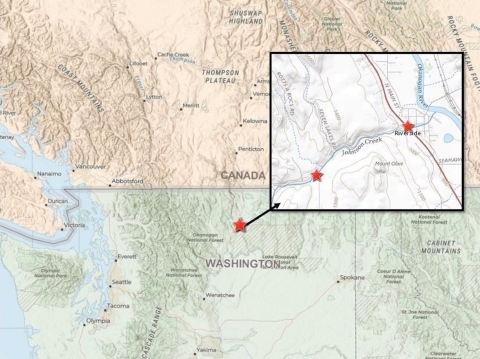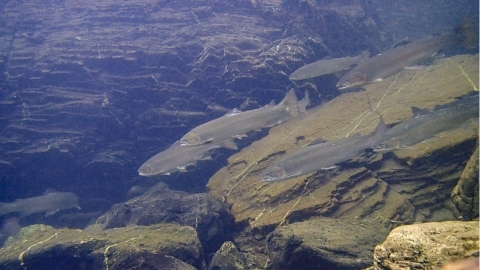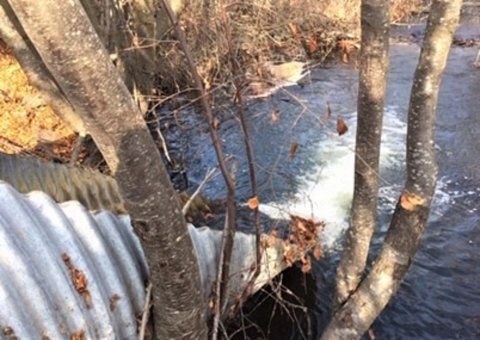By Jan Peterson, for the U.S. Fish and Wildlife Service’s Pacific Region
Replacing a few culverts under roadways in a remote area of Washington may not seem that big of a deal.
But for threatened summer steelhead, it could be a game changer.
These culverts have blocked fish passage fish passage
Fish passage is the ability of fish or other aquatic species to move freely throughout their life to find food, reproduce, and complete their natural migration cycles. Millions of barriers to fish passage across the country are fragmenting habitat and leading to species declines. The U.S. Fish and Wildlife Service's National Fish Passage Program is working to reconnect watersheds to benefit both wildlife and people.
Learn more about fish passage for decades. Removing them will allow summer steelhead access to the cold waters they need for spawning and rearing their young. This access is crucial to their survival.
Kate Terrell — Habitat Restoration and Conservation Program Lead with the U.S. Fish and Wildlife Service’s Mid-Columbia Fish and Wildlife Conservation Office — explains summer steelhead is one of three salmonid species in the Upper Columbia listed under the Endangered Species Act. Steelhead and bull trout are listed as threatened, and spring Chinook are listed as endangered.
The final stages of the Johnson Creek Fish Passage Project have been 7 years in the making. The first of the final two projects was to break ground on Oct. 28. On Nov. 2, with snow and extended below-freezing temperatures forecast, the team decided to avoid winter construction and potential construction challenges and pushed construction to July 1, 2023, when the in-water work window reopens in Johnson Creek. This winter, the team will continue to work through pre-cast production, material procurement, submittal review and scheduling, and hit the ground running in July 2023.
When the project is complete in fall 2023, steelhead will have access to an additional 8 miles of cold water.
Bill Gale, project leader at U.S. Fish and Wildlife Service’s Mid-Columbia Fish and Wildlife Conservation Office says, “The big story is it’s a culmination of efforts that have been going on for a long time to restore passage to this stream. This is something to celebrate.”
Johnson Creek is a rarity among the Okanogan River’s tributaries near the Canadian border, about 45 miles north of where the creek meets the Okanogan River in Riverside, Washington. The river, part of the Columbia River watershed, has headwaters at Okanagan Lake near Penticton, British Columbia, Canada, about 80 miles north of Riverside. The Okanogan River flows into the Columbia River near Brewster, Washington, about 40 miles to the south.
Unlike many tributaries in Okanogan watershed, Johnson Creek doesn’t descend off the plateau and run for a mile or less before joining the Okanogan River, Terrell says. Instead, it is spring-fed and runs through a valley providing 8 miles of habitat for listed steelhead.
Because of its geological features, the Okanogan basin presents fewer opportunities for summer steelhead habitat. “Steelhead need cold water. Projects like Johnson Creek are important because they provide access to the headwaters of the watershed,” says Terrell.
Terrell explains access to that cold water is vital because the Okanogan River system has severe temperature issues. “By the end of July to mid-August, a fair amount of the Okanogan hits a lethal temperature for steelhead, so being able to access tributaries with cold water meets their biological needs. It also provides some areas for spawning and rearing the juveniles.”
“The steelhead populations in the Okanogan are in dire straits. Restoration projects like Johnson Creek are necessary to bolster the existing populations.,” says Terrell.
Theo Burgoon, project manager with Trout Unlimited, says because Johnson Creek is such a small tributary, no one really thought about removing barriers until about 8 years ago. “But it’s spring-fed and flows year-round, so it’s a nice little cold hideaway for summer steelhead,” says Burgoon.
In recent years, populations of summer steelhead have plummeted precipitously. The 2020 Okanogan Subbasin Steelhead Spawning Abundance and Distribution report, published in 2021 by the Colville Confederated Tribe’s Fish and Wildlife Department, shows population survey results for several years. In 2014, for example, a total of 57 steelhead were detected in Johnson Creek. By 2019, that number dropped to three. While methodology changed somewhat in 2020, by then the number was zero.
Terrell says there are a number of things that set the anadromous summer steelhead apart from other salmonids. “One of the coolest things about steelhead is they’re really strong swimmers. Not all of these culverts are 100% passage barriers, but migration delays can affect their reproductive success. Steelhead typically live in fresh water for 1 to 2 years before migrating to the ocean,” she says.
The U.S. Fish and Wildlife Service is only one of the entities working on the project. The project lead is Trout Unlimited. Other partners include the City of Riverside, Washington, and the Confederated Tribes of the Colville Reservation. The groups also worked closely with the Washington Department of Transportation.
Funding for the $2.7 million project includes $600,000 from the Bipartisan Infrastructure Law Bipartisan Infrastructure Law
The Bipartisan Infrastructure Law (BIL) is a once-in-a-generation investment in the nation’s infrastructure and economic competitiveness. We were directly appropriated $455 million over five years in BIL funds for programs related to the President’s America the Beautiful initiative.
Learn more about Bipartisan Infrastructure Law , $210,000 from Confederated Tribes of the Colville Reservation, $270,000 from Mid-Columbia Habitat Conservation Plan Tributary Committee and $1.62 million from the Brian Abbott Fish Barrier Board.
The two projects at Greenacres and State Route 97 will correct the final three passage barriers in the lower 1.2 miles of Johnson Creek.
Terrell says replacing an undersized pipe culvert with an appropriately sized pre-cast concrete box culvert with a stream stimulation channel at Greenacres will be the first project. The final project will involve removing a 6-foot diameter pipe culvert and concrete weir/debris screen. Restoration at the State Road 97 site will include replacing the undersized culvert with a stream simulation channel, removing the weir/debris screen and grading the channel to restore passage at the site.
COVID-19-related supply-chain issues repeatedly delayed completion of the important project. The Greenacres project initially was scheduled to be complete in August. The State Road 97 project is planned for summer 2023. Both are now expected to be completed by fall 2023.
Our public lands, like our roads and bridges, require strategic investments and management to protect the fish and wildlife that is so important to the American public. The Bipartisan Infrastructure Law has committed $455 million to the U.S. Fish and Wildlife Service over five years to support our natural infrastructure and protect these valuable resources.








